-
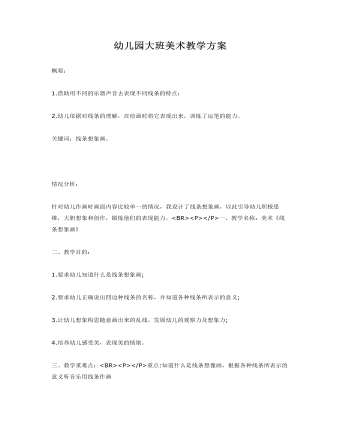
幼儿园大班美术教学方案
2.幼儿依据对线条的理解,在绘画时将它表现出来,训练了运笔的能力。关键词:线条想象画。情况分析:针对幼儿作画时画面内容比较单一的情况,我设计了线条想象画,以此引导幼儿积极思维,大胆想象和创作,锻炼他们的表现能力。<BR><P></P>一、教学名称:美术《线条想象画》二、教学目的:1.要求幼儿知道什么是线条想象画;2.要求幼儿正确说出四边种线条的名称,并知道各种线条所表示的意义; 3.让幼儿想象构思随意画出来的乱线,发展幼儿的观察力及想象力;4.培养幼儿感受美,表现美的情绪。三、教学重难点:<BR><P></P>重点:知道什么是线条想像画,根据各种线条所表示的意义听音乐用线条作画难点:根据自己的线条想象构思,使它变成一个或多个物体的的形象四、教学准备:录相带、录相机、投影机、幻灯片、录音机、磁带、龙头饰一个,纸、笔、油画棒若干,各种小乐器,四个线条娃娃,两幅幻灯范画。五、教学过程:(1)看录相引出舞龙灯,引起幼儿的兴趣“今天,老师让小朋友看一段非常好看的录相,请看吧!”幼儿看过录相后,引导幼儿说出录相里人们舞龙,老师讲一些关于舞龙方面的知识,然后带领幼儿根据录相也来舞龙。<BR><P></P>(2)线条娃娃舞龙灯,教师示范强调“刚才,小朋友舞龙灯时无意中已经走成了许多美丽的线条,你们想认识他们吗?”(1)利用不同小乐器的声音引出四位线条娃娃,使幼儿知道各种线条的名称及所代表的意义。例如:听到大鼓的声音,折线娃娃走出来,表示折线和鼓声一样粗壮有力。听到小铃声的声音波浪线,娃娃走出来,表示波浪线和铃声一样优美、婉转。
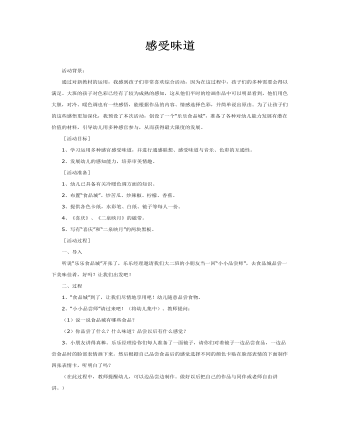
大班科学教案:感受味道
[活动目标]1、学习运用多种感官感受味道,并进行通感联想、感受味道与音乐、色彩的互通性。2、发展幼儿的感知能力,培养审美情趣。 [活动准备]1、幼儿已具备有关冷暖色调方面的知识。2、布置“食品城”。炒苦瓜、炒辣椒、柠檬、香蕉。3、提供各色卡纸,水彩笔、白纸、镜子等每人一份。4、《喜庆》、《二泉映月》的磁带。5、写有“喜庆”和“二泉映月”的两块黑板。 [活动过程]
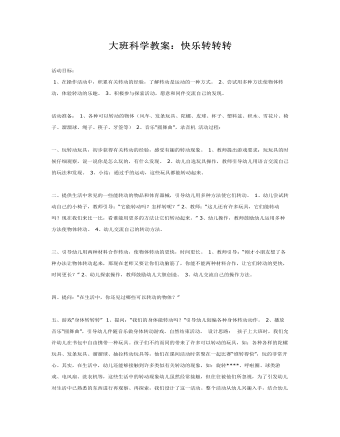
大班科学教案:快乐转转转
活动准备: 1、各种可以转动的物体(风车、发条玩具、陀螺、皮球、杯子、塑料盆、积木、雪花片、椅子、溜溜球、绳子、筷子、牙签等) 2、音乐“圆舞曲”,录音机活动过程: 一、玩转动玩具,初步获得有关转动的经验,感受有趣的转动现象。 1、教师提出游戏要求:玩玩具的时候仔细观察,说一说你是怎么玩的,有什么发现。 2、幼儿自选玩具操作,教师引导幼儿用语言交流自己的玩法和发现。 3、小结:通过手的运动,这些玩具都能转动起来。 二、提供生活中常见的一些能转动的物品和体育器械,引导幼儿用多种方法使它们转动。 1、幼儿尝试转动自己的小椅子,教师引导:“它能转动吗?怎样转呢?” 2、教师:“这儿还有许多玩具,它们能转动吗?现在我们来比一比,看谁能用更多的方法让它们转动起来。” 3、幼儿操作,教师鼓励幼儿运用多种方法使物体转动。 4、幼儿交流自己的转动方法。
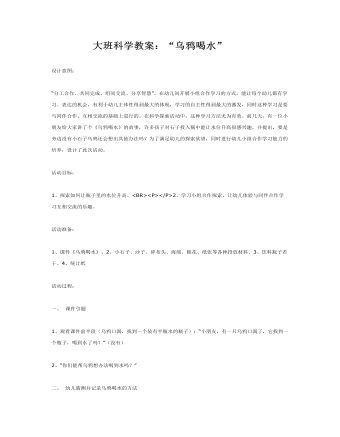
大班科学教案:“乌鸦喝水”
活动目标:1、探索如何让瓶子里的水位升高。<BR><P></P>2、学习小组合作探索,让幼儿体验与同伴合作学习互相交流的乐趣。活动准备:1、课件《乌鸦喝水》、2、小石子、沙子、碎布头、海绵、棉花、纸张等各种投放材料、3、饮料瓶子若干、4、统计纸活动过程:一、 课件引题1、观看课件前半段(乌鸦口渴,找到一个装有半瓶水的瓶子):“小朋友,有一只乌鸦口渴了,它找到一个瓶子,喝到水了吗?”(没有)2、“你们能帮乌鸦想办法喝到水吗?”
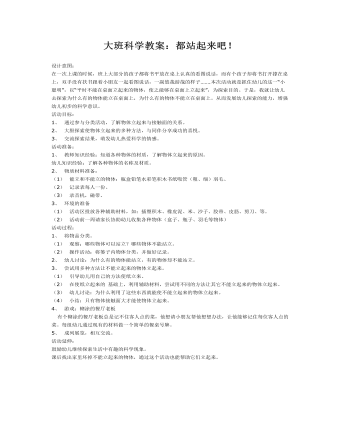
大班科学教案:都站起来吧!
活动目标: 1、 通过参与分类活动,了解物体立起来与接触面的关系。 2、 大胆探索使物体立起来的多种方法,与同伴分享成功的喜悦。 3、 交流探索结果,萌发幼儿热爱科学的情感。 活动准备: 1、 教师知识经验:知道各种物体的材质,了解物体立起来的原因。 幼儿知识经验:了解各种物体的名称及材质。 2、 物质材料准备: (1) 能立和不能立的物体:瓶盒铅笔水彩笔积木书纸吸管(粗、细)羽毛、 (2) 记录表每人一份。 (3) 录音机,磁带。 3、 环境的准备 (1) 活动区投放各种辅助材料,如:插塑积木、橡皮泥、米、沙子、胶带、皮筋、剪刀、等。 (2) 活动前一周请家长协助幼儿收集各种物体(盒子、瓶子、羽毛等物体)
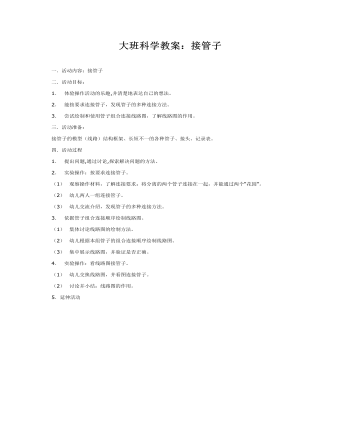
大班科学教案:接管子
二.活动目标: 1. 体验操作活动的乐趣,并清楚地表达自己的想法。 2. 能按要求连接管子,发现管子的多种连接方法。 3. 尝试绘制和使用管子组合连接线路图,了解线路图的作用。 三.活动准备: 接管子的模型(线路)结构框架、长短不一的各种管子、接头、记录表。 四.活动过程 1. 提出问题,通过讨论,探索解决问题的方法。 2. 实验操作:按要求连接管子。
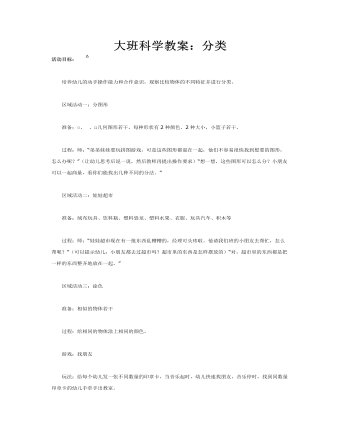
大班科学教案:分类
区域活动一:分图形 准备;○、△、□几何图形若干,每种形状有2种颜色、2种大小,小篮子若干。 过程:师:“弟弟妹妹要玩拼图游戏,可是这些图形都混在一起,他们不容易很快找到想要的图形,怎么办呢?”(让幼儿思考后说一说,然后教师再提出操作要求)“想一想,这些图形可以怎么分?小朋友可以一起商量,看你们能找出几种不同的分法。” 区域活动二:娃娃超市 准备:绒布玩具、饮料瓶、塑料恐龙、塑料水果、衣服、玩具汽车、积木等
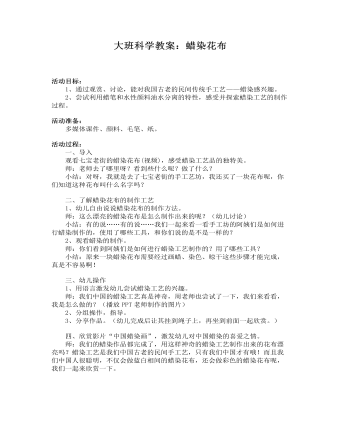
大班科学教案:蜡染花布
活动准备: 多媒体课件、颜料、毛笔、纸。活动过程: 一、导入 观看七宝老街的蜡染花布(视频),感受蜡染工艺品的独特美。 师:老师去了哪里呀?看到些什么呢?做了什么? 小结:对呀,我就是去了七宝老街的手工艺坊,我还买了一块花布呢,你们知道这种花布叫什么名字吗? 二、了解蜡染花布的制作工艺 1、幼儿自由说说蜡染花布的制作方法。 师:这么漂亮的蜡染花布是怎么制作出来的呢?(幼儿讨论) 小结:有的说……有的说……我们一起来看一看手工坊的阿姨们是如何进行蜡染制作的,使用了哪些工具,和你们说的是不是一样的? 2、观看蜡染的制作。 师:你们看到阿姨们是如何进行蜡染工艺制作的?用了哪些工具? 小结:原来一块蜡染花布需要经过画蜡、染色、晾干这些步骤才能完成,真是不容易啊!
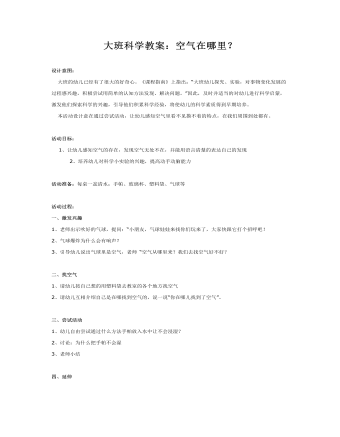
大班科学教案:空气在哪里?
活动目标: 1、让幼儿感知空气的存在,发现空气无处不在,并能用语言清楚的表达自己的发现 2、培养幼儿对科学小实验的兴趣,提高动手动脑能力 活动准备:每桌一盆清水;手帕、玻璃杯、塑料袋、气球等 活动过程:一、激发兴趣1、老师出示吹好的气球,提问:“小朋友,气球娃娃来找你们玩来了,大家快跟它打个招呼吧!2、气球爆炸为什么会有响声?3、引导幼儿说出气球里是空气,老师 “空气从哪里来?我们去找空气好不好?
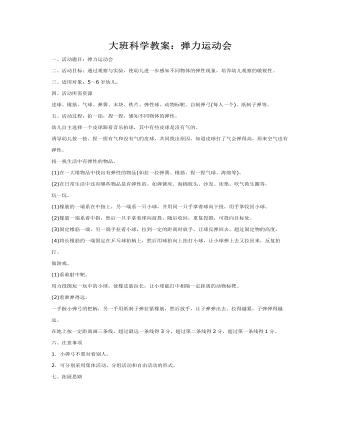
大班科学教案:弹力运动会
二、活动目标:通过观察与实验,使幼儿进一步感知不同物体的弹性现象,培养幼儿观察的敏锐性。三、适用对象:5~6岁幼儿。四、活动所需资源皮球、橡筋、气球、弹簧、木块、铁片、弹性球、动物标靶、自制弹弓(每人一个)、纸制子弹等。五、活动过程:拍一拍,捏一捏,感知不同物体的弹性。幼儿自主选择一个皮球跟着音乐拍球,其中有些皮球是没有气的。诱导幼儿按一按、捏一捏有气和没有气的皮球,共同找出原因,知道皮球打了气会弹得高,原来空气也有弹性。找一找生活中有弹性的物品。(1)在一大堆物品中找出有弹性的物品(如拉一拉弹簧、橡筋、捏一捏气球、海绵等)。(2)在日常生活中还有哪些物品是有弹性的。如弹簧床、海棉枕头、沙发、床垫、吹气救生圈等。玩一玩。(1)橡筋的一端系在中指上,另一端系一只小球,并用同一只手拿着球向下投,用手掌收回小球。(2)橡筋一端系着中指,然后一只手拿着球向前投,随后收回,重复投掷,可投向目标处。(3)固定橡筋一端,另一端手拉着小球,拉到一定的距离时放手,让球反弹回去,超过固定物的高度。(4)将长橡筋的一端固定在乒乓球拍柄上,然后用球拍向上拍打小球,让小球弹上去又拉回来,反复拍打。做游戏。
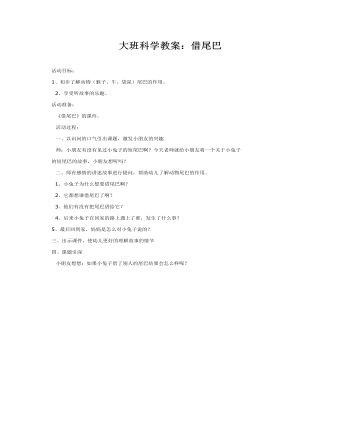
大班科学教案:借尾巴
2、享受听故事的乐趣。活动准备: 《借尾巴》的课件。 活动过程: 一、以讯问的口气引出课题,激发小朋友的兴趣 师:小朋友有没有见过小兔子的短尾巴啊?今天老师就给小朋友将一个关于小兔子的短尾巴的故事,小朋友想听吗? 二、师有感情的讲述故事进行提问,帮助幼儿了解动物尾巴的作用。 1、小兔子为什么想要借尾巴啊?
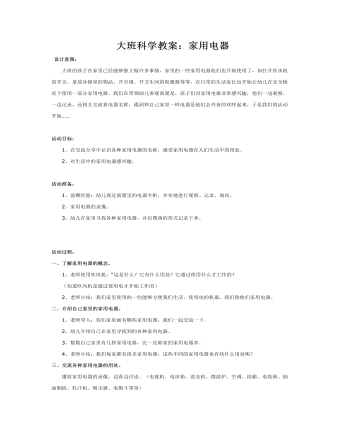
大班科学教案:家用电器
活动目标:1、在交流分享中认识各种家用电器的名称,感受家用电器在人们生活中的用处。2、对生活中的家用电器感兴趣。 活动准备:1、前期经验:幼儿观过商厦里的电器专柜,并实地进行观察、记录、询问。2、家用电器的录像。3、幼儿在家里寻找各种家用电器,并以图画的形式记录下来。 活动过程:一、了解家用电器的概念。1、老师使用吹风机:“这是什么?它有什么用处?它通过使用什么才工作的? (知道吹风机是通过使用电才开始工作的)2、老师小结:我们家里使用的一些能够方便我们生活、使用电的机器,我们称他们家用电器。二、介绍自己家里的家用电器。1、老师导入:你们家里面有哪些家用电器,我们一起交流一下。2、幼儿介绍自己在家里寻找到的各种家用电器。3、数数自己家里有几样家用电器,比一比谁家的家用电器多。4、老师小结:我们每家都有很多家用电器,这些不同的家用电器也有些什么用处呢?三、交流各种家用电器的用处。 播放家用电器的录像,边看边讨论。(电视机、电冰箱、洗衣机、微波炉、空调、浴霸、电饭锅、抽油烟机、轧汁机、吸尘器、电熨斗等等)1、这是什么?有什么用处?2、它们的形状、颜色一样吗?为什么要不一样?(满足人们不同的喜好)3、随机提问:你同意他的说法吗?还有什么意见?4、你们还有什么问题吗?可以提出来大家一起讨论?5、老师小结:家用电器用处可真大,它们给我们生活带来了方便。

小班科学教案 挖土大力士
【活动准备】1、活动开展前教师和家长应带幼儿观察建筑工地。2、准备各种挖土工具的图书、图片、录像等资料。3、收集玩具挖土机。 【活动过程】1、导入:小朋友,你们见过挖土机吗?谁能说一说挖土机有什么本领?2、观看录象:在各种不同场所工作着的挖土机。 (1)请幼儿仔细观察挖土机是怎样工作的。 (2)请幼儿观察挖土机用什么挖土?像什么? (3)让幼儿学着挖土机按顺序作挖土的动作。 (4)引导幼儿用语言描述挖土机的样子以及它挖土的动作。
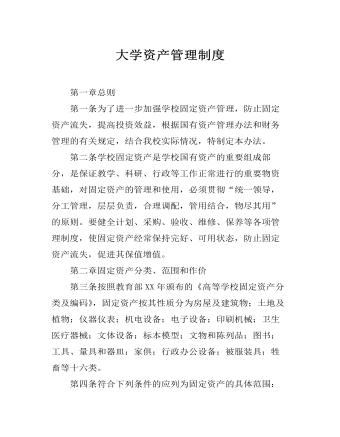
大学资产管理制度
第二条学校固定资产是学校国有资产的重要组成部分,是保证教学、科研、行政等工作正常进行的重要物资基础,对固定资产的管理和使用,必须贯彻“统一领导,分工管理,层层负责,合理调配,管用结合,物尽其用”的原则。要健全计划、采购、验收、维修、保养等各项管理制度,使固定资产经常保持完好、可用状态,防止固定资产流失,促进其保值增值。 第二章固定资产分类、范围和作价 第三条按照教育部XX年颁布的《高等学校固定资产分类及编码》,固定资产按其性质分为房屋及建筑物;土地及植物;仪器仪表;机电设备;电子设备;印刷机械;卫生医疗器械;文体设备;标本模型;文物和陈列品;图书;工具、量具和器皿;家俱;行政办公设备;被服装具;牲畜等十六类。 第四条符合下列条件的应列为固定资产的具体范围: ㈠单价在500元以上,耐用期在一年以上,并能在原有状态下独立使用的教学、科研、行政办公、生活后勤物资设备;
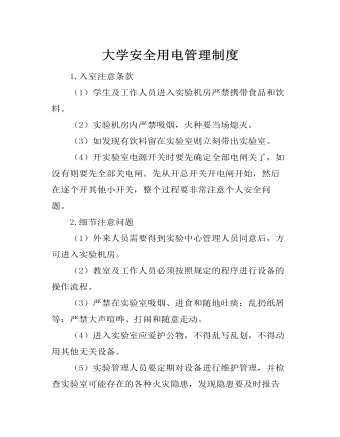
大学安全用电管理制度
2.细节注意问题 (1)外来人员需要得到实验中心管理人员同意后,方可进入实验机房。 (2)教室及工作人员必须按照规定的程序进行设备的操作流程。 (3)严禁在实验室吸烟、进食和随地吐痰:乱扔纸屑等:严禁大声喧哗、打闹和随意走动。 (4)进入实验室应爱护公物,不得乱写乱划,不得动用其他无关设备。
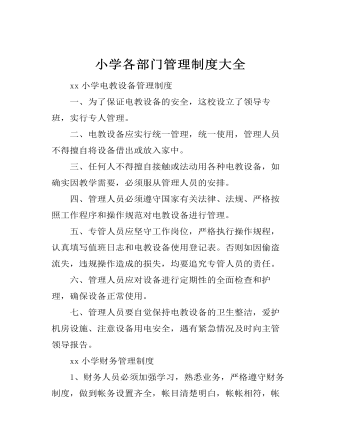
小学各部门管理制度大全
二、电教设备应实行统一管理,统一使用,管理人员不得擅自将设备借出或放入家中。 三、任何人不得擅自接触或法动用各种电教设备,如确实因教学需要,必须服从管理人员的安排。 四、管理人员必须遵守国家有关法律、法规、严格按照工作程序和操作规范对电教设备进行管理。 五、专管人员应坚守工作岗位,严格执行操作规程,认真填写值班日志和电教设备使用登记表。否则如因偷盗流失,违规操作造成的损失,均要追究专管人员的责任。 六、管理人员应对设备进行定期性的全面检查和护理,确保设备正常使用。
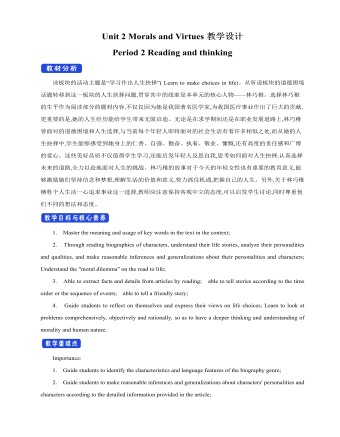
新人教版高中英语必修3Unit 2 Morals and Virtues教学设计二
Activity 41. Students complete the task of activity 4, then teachers and students check the answers. 2. The teacher organized the students to work together and asked them to use the tables and mind maps sorted out before to retold the important choices in Lin Qiaozhi's life and their resultsStep 5 Language points1. The teacher asks the students to read the text carefully, find out the core words and long and difficult sentences in the text and draw lines, understand the use of vocabulary, and analyze the structure of long and difficult sentences. 2. The teacher explains and summarizes the usage of core vocabulary and asks the students to take notes. 3. The teacher analyzes and explains the long and difficult sentences that the students don't understand, so that the students can understand them better. Step 6 Homework1. Read the text again, in-depth understanding of the text; 2. Master the use of core vocabulary and understand the long and difficult sentences. 3. Complete relevant exercises in the guide plan. 1、通过本节内容学习,学生是否理解和掌握阅读文本中的新词汇的意义与用法;2、通过本节内容学习,学生能否结合文本特点总结林巧稚的人生原则和人格品质特征;3、通过本节内容学习,学生能否针对人生抉择发表自己的看法;能否全面地、客观地、理性地看待问题,进而对道德和人性有更加深入的思考和理解。
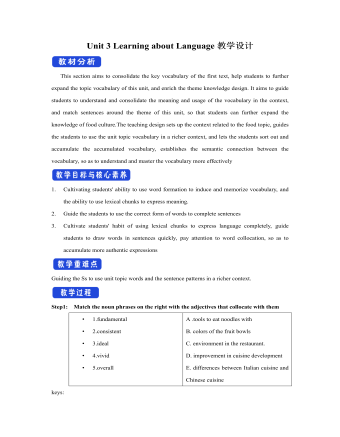
新人教版高中英语选修2Unit 3 Learning about Language教学设计
1. We'll need ten months at least to have the restaurant decorated.2.Some traditional Chinese dishes from before the Ming Dynasty are still popular today.3.My grandpa's breakfast mainly includes whole grain biscuits and a glass of milk.4.People in this area would eat nearly a kilo of cheese per week.5. We enjoyed a special dinner in a fancy restaurant where the waiters all wore attractive suits.6. He prefers this brand of coffee which, as he said, has an unusually good flavor.Key:1. at a minimum 2. prior to3. consist of4. consume5. elegant6. exceptionalStep 5:Familiarize yourself with some food idioms by matching the meaning on the right with the colored words on the left.1.Public concern for the health of farm animals has mushroomed in the UK2.Anderson may be young but he's certainly rolling to doing dough!3.George is a popular lecturer. He often peppers his speech with jokes.4.As the person to bring home the bacon, he needs to find a stable job.5 He is often regarded as a ham actor for his over emphasized facial expressions. The media reported that these companies had treated pollution as a hot potato. 6.The media reported that these companies had treated pollution as a hot potato.7.Don't worry about the test tomorrow. It's going to be a piece of cake!8. It's best to fold the swimming ring when it is as flat as a pancake.A. completely flatB. something that is very easy to do C.an issue that is hard to deal withD.to include large numbers of somethingE.to earn on e's living to support a familyF. wealthyG.to rapidly increase in numberH. an actor who performs badly, especially by over emphasizing emotions
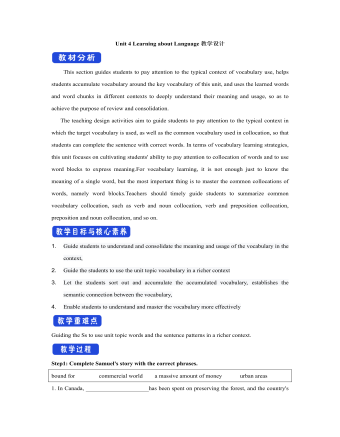
新人教版高中英语选修2Unit 4 Learning about Language教学设计
This section guides students to pay attention to the typical context of vocabulary use, helps students accumulate vocabulary around the key vocabulary of this unit, and uses the learned words and word chunks in different contexts to deeply understand their meaning and usage, so as to achieve the purpose of review and consolidation.The teaching design activities aim to guide students to pay attention to the typical context in which the target vocabulary is used, as well as the common vocabulary used in collocation, so that students can complete the sentence with correct words. In terms of vocabulary learning strategies, this unit focuses on cultivating students' ability to pay attention to collocation of words and to use word blocks to express meaning.For vocabulary learning, it is not enough just to know the meaning of a single word, but the most important thing is to master the common collocations of words, namely word blocks.Teachers should timely guide students to summarize common vocabulary collocation, such as verb and noun collocation, verb and preposition collocation, preposition and noun collocation, and so on.1. Guide students to understand and consolidate the meaning and usage of the vocabulary in the context, 2. Guide the students to use the unit topic vocabulary in a richer context3. Let the students sort out and accumulate the accumulated vocabulary, establishes the semantic connection between the vocabulary,4. Enable students to understand and master the vocabulary more effectivelyGuiding the Ss to use unit topic words and the sentence patterns in a richer context.
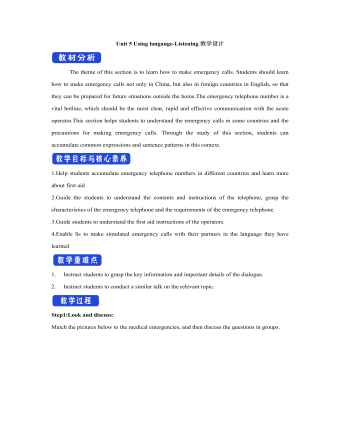
新人教版高中英语选修2Unit 5 Using langauge-Listening教学设计
The theme of this section is to learn how to make emergency calls. Students should learn how to make emergency calls not only in China, but also in foreign countries in English, so that they can be prepared for future situations outside the home.The emergency telephone number is a vital hotline, which should be the most clear, rapid and effective communication with the acute operator.This section helps students to understand the emergency calls in some countries and the precautions for making emergency calls. Through the study of this section, students can accumulate common expressions and sentence patterns in this context. 1.Help students accumulate emergency telephone numbers in different countries and learn more about first aid2.Guide the students to understand the contents and instructions of the telephone, grasp the characteristics of the emergency telephone and the requirements of the emergency telephone.3.Guide students to understand the first aid instructions of the operators.4.Enable Ss to make simulated emergency calls with their partners in the language they have learned1. Instruct students to grasp the key information and important details of the dialogue.2. Instruct students to conduct a similar talk on the relevant topic.Step1:Look and discuss:Match the pictures below to the medical emergencies, and then discuss the questions in groups.

